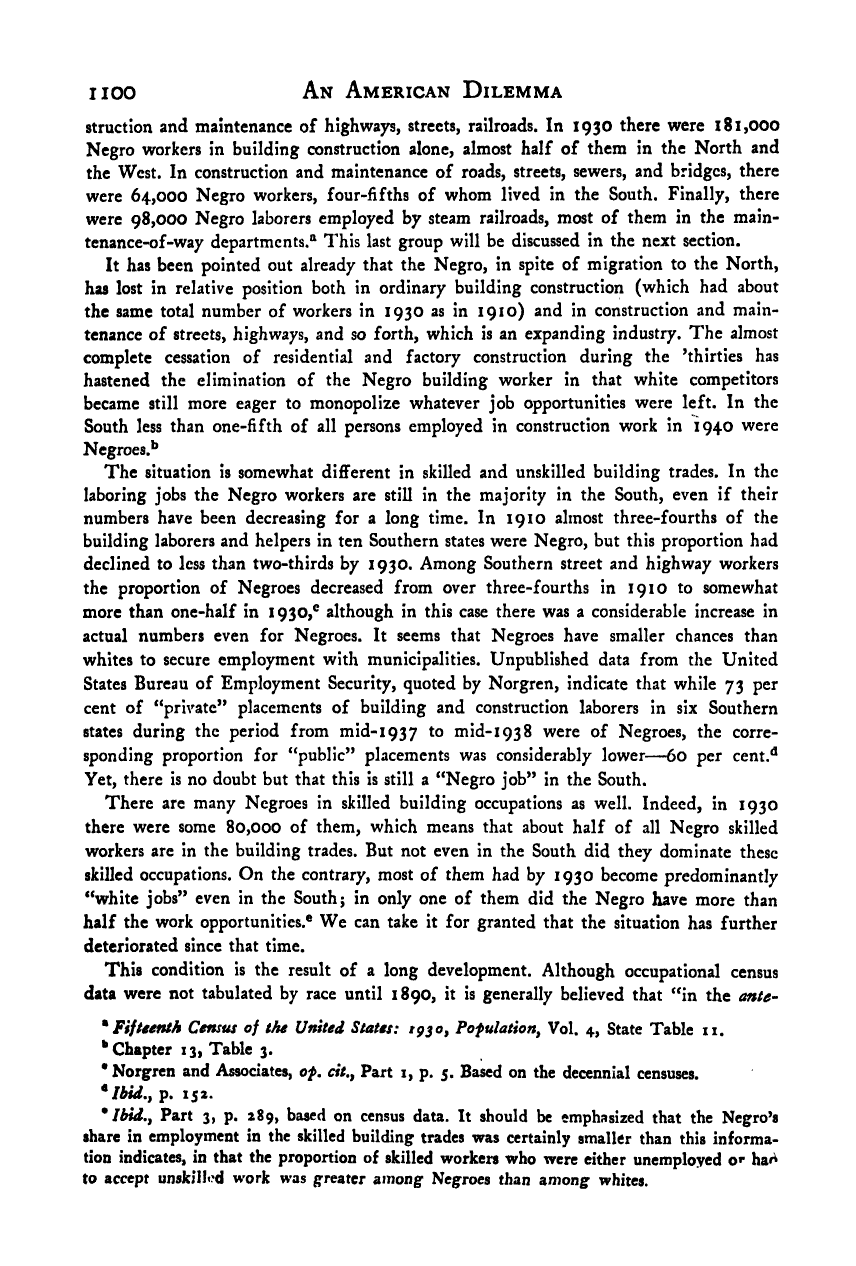Note: Gunnar Myrdal died in 1987, less than 70 years ago. Therefore, this work is protected by copyright, restricting your legal rights to reproduce it. However, you are welcome to view it on screen, as you do now. Read more about copyright.
Full resolution (TIFF) - On this page / på denna sida - Appendices - 6. Pre-War Conditions of the Negro Wage Earner in Selected Industries and Occupations - 8. Building Workers

<< prev. page << föreg. sida << >> nästa sida >> next page >>
Below is the raw OCR text
from the above scanned image.
Do you see an error? Proofread the page now!
Här nedan syns maskintolkade texten från faksimilbilden ovan.
Ser du något fel? Korrekturläs sidan nu!
This page has never been proofread. / Denna sida har aldrig korrekturlästs.
1100 An American Dilemma
struction and maintenance of highways, streets, railroads. In 1930 there were 1 81,000
Negro workers in building construction alone, almost half of them in the North and
the West. In construction and maintenance of roads, streets, sewers, and bridges, there
were 64,000 Negro workers, four-fifths of whom lived in the South. Finally, there
were 98,000 Negro laborers employed by steam railroads, most of them in the main-
tenance-of-way departments.*^ This last group will be discussed in the next section.
It has been pointed out already that the Negro, in spite of migration to the North,
has lost in relative position both in ordinary building construction (which had about
the same total number of workers in 1930 as in 1910) and in construction and main-
tenance of streets, highways, and so forth, which is an expanding industry. The almost
complete cessation of residential and factory construction during the ’thirties has
hastened the elimination of the Negro building worker in that white competitors
became still more eager to monopolize whatever job opportunities were left. In the
South less than one-fifth of all persons employed in construction work in 1940 were
Negroes.**
The situation is somewhat different in skilled and unskilled building trades. In the
laboring jobs the Negro workers are still in the majority in the South, even if their
numbers have been decreasing for a long time. In 1910 almost three-fourths of the
building laborers and helpers in ten Southern states were Negro, but this proportion had
declined to less than two-thirds by 1930. Among Southern street and highway workers
the proportion of Negroes decreased from over three-fourths in 1910 to somewhat
more than one-half in 1930,® although in this case there was a considerable increase in
actual numbers even for Negroes. It seems that Negroes have smaller chances than
whites to secure employment with municipalities. Unpublished data from the United
States Bureau of Employment Security, quoted by Norgren, indicate that while 73 per
cent of “private” placements of building and construction laborers in six Southern
states during the period from mid- 1937 to mid- 193 8 were of Negroes, the corre-
sponding proportion for “public” placements was considerably lower—60 per cent.**
Yet, there is no doubt but that this is still a “Negro job” in the South.
There are many Negroes in skilled building occupations as well. Indeed, in 1930
there were some 80,000 of them, which means that about half of all Negro skilled
workers are in the building trades. But not even in the South did they dominate these
skilled occupations. On the contrary, most of them had by 1930 become predominantly
“white jobs” even in the South; in only one of them did the Negro have more than
half the work opportunities.® We can take it for granted that the situation has further
deteriorated since that time.
This condition is the result of a long development. Although occupational census
data were not tabulated by race until 1890, it is generally believed that “in the ante-
* Fifteenth Census of the United States: tp^o, Pofulation, Vol. 4, State Table ii.
^Chapter 13, Table 3.
* Norgren and Associates, of, cit,^ Part i, p. 5. Based on the decennial censuses.
p. 152.
* Ibid,, Part 3, p. 289, based on census data. It should be emphasized that the Negro’s
share in employment in the skilled building trades was certainly smaller than this informa-
tion indicates, in that the proportion of skilled workers who were either unemployed o** ha^
to accept unskilh’d work was greater among Negroes than among whites.
<< prev. page << föreg. sida << >> nästa sida >> next page >>